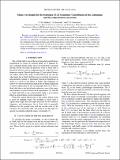Magic wavelength for the hydrogen
Author(s)
Adhikari, C. M.; Jentschura, U. D.; Kawasaki, Akio
DownloadPhysRevA.94.032510.pdf (92.62Kb)
PUBLISHER_POLICY
Publisher Policy
Article is made available in accordance with the publisher's policy and may be subject to US copyright law. Please refer to the publisher's site for terms of use.
Terms of use
Metadata
Show full item recordAbstract
Recently, we studied the magic wavelength for the atomic hydrogen 1S−2S transition [A. Kawasaki, Phys. Rev. A 92, 042507 (2015)]. An explicit summation over virtual atomic states of the discrete part of the hydrogen spectrum was performed to evaluate the atomic polarizability. In this paper, we supplement the contribution of the continuum part of the spectrum and add the reduced-mass correction. The magic wavelength, at which the lowest-order ac Stark shifts of the 1S and 2S states are equal, is found to be 514.6 nm. The ac Stark shift at the magic wavelength is −221.6Hz/(kW/cm[superscript 2]), and the slope of the ac Stark shift at the magic wavelength under a change of the driving laser frequency is −0.2157Hz/[GHz(kW/cm[superscipt 2])].
Date issued
2016-09Department
Massachusetts Institute of Technology. Department of Physics; MIT-Harvard Center for Ultracold AtomsJournal
Physical Review A
Publisher
American Physical Society
Citation
Adhikari, C. M., A. Kawasaki, and U. D. Jentschura. “Magic Wavelength for the Hydrogen 1 S − 2 S Transition: Contribution of the Continuum and the Reduced-Mass Correction.” Physical Review A 94.3 (2016): n. pag. © 2016 American Physical Society
Version: Final published version
ISSN
2469-9926
2469-9934